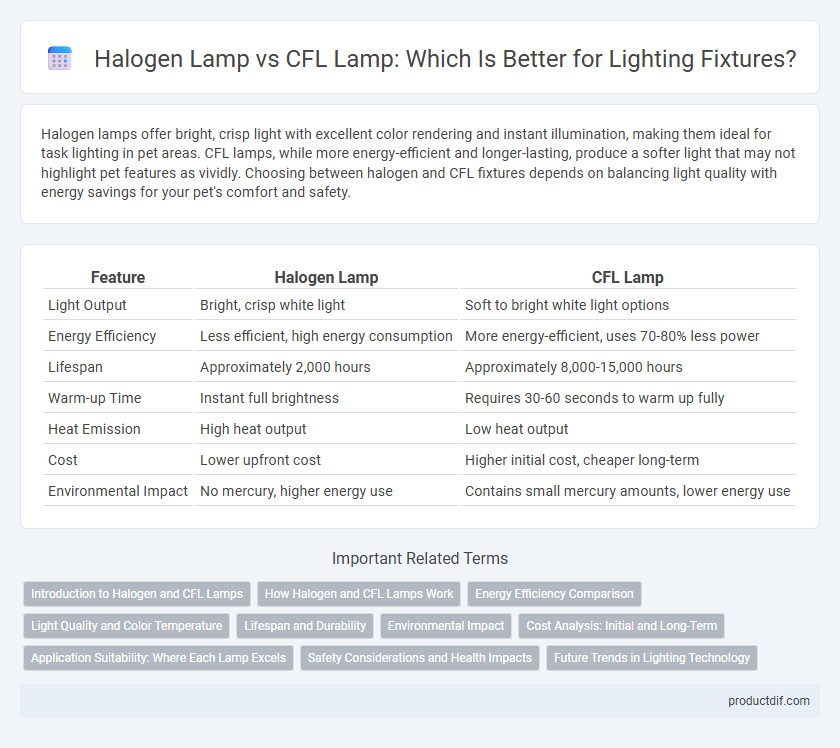Halogen lamps offer bright, crisp light with excellent color rendering and instant illumination, making them ideal for task lighting in pet areas. CFL lamps, while more energy-efficient and longer-lasting, produce a softer light that may not highlight pet features as vividly. Choosing between halogen and CFL fixtures depends on balancing light quality with energy savings for your pet's comfort and safety.
Table of Comparison
| Feature | Halogen Lamp | CFL Lamp |
|---|---|---|
| Light Output | Bright, crisp white light | Soft to bright white light options |
| Energy Efficiency | Less efficient, high energy consumption | More energy-efficient, uses 70-80% less power |
| Lifespan | Approximately 2,000 hours | Approximately 8,000-15,000 hours |
| Warm-up Time | Instant full brightness | Requires 30-60 seconds to warm up fully |
| Heat Emission | High heat output | Low heat output |
| Cost | Lower upfront cost | Higher initial cost, cheaper long-term |
| Environmental Impact | No mercury, higher energy use | Contains small mercury amounts, lower energy use |
Introduction to Halogen and CFL Lamps
Halogen lamps are a type of incandescent lighting that uses halogen gas to increase light output and lifespan, providing bright, white light with excellent color rendering. Compact Fluorescent Lamps (CFLs) use a gas-filled tube and a small amount of mercury vapor to produce light through fluorescence, offering energy efficiency and longer life than traditional incandescent bulbs. Both types serve different lighting needs, with halogens preferred for high-quality, focused illumination and CFLs favored for energy-saving, general-purpose lighting.
How Halogen and CFL Lamps Work
Halogen lamps operate by passing an electric current through a tungsten filament enclosed in a small quartz envelope filled with halogen gas, which increases the lifespan and maintains brightness. CFL lamps function by driving electricity through a gas-filled tube, causing the gas to emit ultraviolet light that excites a phosphor coating inside the tube, producing visible light. The distinct mechanisms result in different energy efficiency, lifespan, and color temperature characteristics between halogen and CFL lamps.
Energy Efficiency Comparison
Halogen lamps consume significantly more energy than CFL lamps, often using up to three times the wattage to produce the same amount of light. CFL lamps convert a higher percentage of energy into visible light, resulting in energy savings of approximately 70-80% compared to halogen lamps. This efficiency translates into lower electricity bills and a reduced environmental footprint when opting for CFL lighting fixtures.
Light Quality and Color Temperature
Halogen lamps produce a warm, natural light with a color temperature typically around 2700K to 3200K, closely mimicking natural daylight and offering excellent color rendering with a CRI (Color Rendering Index) near 100. CFL (Compact Fluorescent Lamp) fixtures vary in color temperature, commonly ranging from 2700K to 6500K, providing options from warm white to daylight, but generally have a lower CRI around 80, resulting in less accurate color representation. The superior light quality of halogen lamps makes them ideal for applications requiring true color perception, while CFLs prioritize energy efficiency with more variable light quality.
Lifespan and Durability
Halogen lamps typically offer a lifespan of around 2,000 to 4,000 hours, making them less durable compared to CFL (Compact Fluorescent Lamp) bulbs, which can last between 8,000 and 10,000 hours. CFL lamps contain fragile components and a small amount of mercury but generally withstand frequent switching better than halogen bulbs, which can be sensitive to vibrations and heat. Choosing CFLs enhances longevity and reliability in lighting fixtures, especially in applications requiring extended use.
Environmental Impact
Halogen lamps consume more electricity and have a shorter lifespan, leading to increased energy use and higher carbon emissions compared to CFL lamps. CFL lamps use up to 75% less energy and last up to 10 times longer, significantly reducing environmental waste and greenhouse gas emissions. Mercury content in CFL lamps requires proper disposal to prevent environmental contamination, whereas halogen lamps do not contain hazardous materials but contribute to greater overall energy consumption.
Cost Analysis: Initial and Long-Term
Halogen lamps typically have a lower initial purchase price but higher energy consumption, resulting in increased electricity costs over time. Compact Fluorescent Lamps (CFLs) incur a higher upfront cost but offer significant savings through energy efficiency and longer lifespan, reducing overall expenses in the long term. Evaluating both initial investment and cumulative energy costs highlights CFLs as the more cost-effective lighting solution despite their higher initial price.
Application Suitability: Where Each Lamp Excels
Halogen lamps excel in applications requiring bright, focused light and excellent color rendering, such as task lighting, display lighting, and outdoor floodlighting. CFL lamps are ideal for general ambient lighting in homes and offices due to their energy efficiency and longer lifespan compared to incandescent bulbs. The choice between halogen and CFL depends on the need for instant full brightness and warm light versus energy savings and reduced heat emission.
Safety Considerations and Health Impacts
Halogen lamps generate intense heat posing burn and fire hazards if improperly handled, whereas CFL lamps contain small amounts of mercury requiring careful disposal to prevent environmental contamination. Exposure to UV radiation from halogen bulbs can lead to skin and eye irritation, while CFLs may cause issues for individuals sensitive to flicker or those with mercury allergies. Choosing lighting fixtures that balance safety features and health impacts is crucial for residential and commercial environments.
Future Trends in Lighting Technology
Halogen lamps are being rapidly phased out due to energy inefficiency, while CFL lamps, though more efficient, are also losing ground to LED technology in future lighting trends. Advances in smart lighting systems prioritize LEDs for their longevity, lower energy consumption, and compatibility with IoT devices. Emerging trends include tunable white LEDs and human-centric lighting, which enhance user experience and energy savings compared to traditional halogen and CFL lamps.
Halogen lamp vs CFL lamp Infographic

 productdif.com
productdif.com